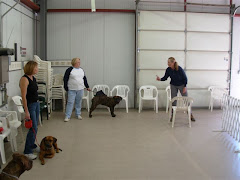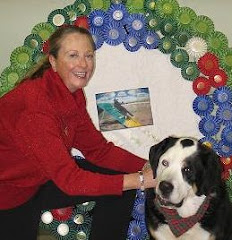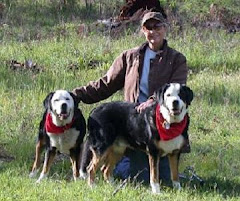Imagine yourself, an ardent dog lover, stuck in such a facility and cut off from the world, your family, your animals. What would you give to just see and pet a friendly dog, even if it's not your own? You might give everything you had, since dogs can offer us joys that nothing else can. Next time you drive past that nursing home on your way to work, remember that there are dozens of residents in there just like you. Seeing and touching a dog would likely be the highlight of their day, or maybe even their week.
For years I've been making occasional visits with my dogs. In Yakima we started with our Rottweilers, Scout and Teddy. Our Swissies were not good candidates for therapy dogs, but our pit bull, Lizzie, is exemplary. So Lizzie has a new job. Each Tuesday we visit the residents of the local nursing home. Lizzie goes room to room, hops up on beds when she's invited, and patiently waits for feeble hands to reach out to her. I put a piece of kibble in the person's hand, they extend the hand to Lizzie, and their eyes light up with glee as she politely takes it from their open palm.
You can do this too, and you should. You do not need to go through any special therapy dog training to do this, nor do you need any special certification. You can walk in next week with your dog and begin spreading cheer...if you have the right dog and the right facility.
Not sure your dog can cut the mustard? Here's what makes a good therapy dog for nursing homes:
- They're quiet...no barking, no growling.
- They're squeaky clean and low-shedding, and their nails aren't sharp.
- They're not rambunctious; they won't pull on the leash or jump up on people.
- They're not shy or timid; nursing homes can be pretty frightening to skiddish dogs.
- They're patient and tolerant of distractions, clumsiness, waiting around, and even being ignored.
- They're healthy.
Granted, that rudimentary list eliminates a lot of prospects, but certainly not all. If your dog is still in the running, let's talk about what you have to do.
1. Call a local nursing home and ask about their policy on visiting therapy dogs. While some facilities will require special documentation, most will not. They're simply delighted to have someone like you step forward and offer to visit. They will assume you know what you're doing with your dog.
2. If you do get the cold shoulder from one facility, try another.
3. Be "self insured." This means knowing--objectively--your dog's shortcomings and adamantly protecting him from situations that could emphasize them.
- Example: your dog is big and heavy. Make sure he doesn't have the chance to jump up on a bed unless you're there to assist. That way, he can't accidentally injure or bruise a patient.
- Example: your dog likes to give face "kisses." If a patient is reacting negatively to your dog's closeness, don't allow your dog to sneak one in, since someone might call it a bite.
- Example: your dog has a long tail. While you're visiting with patients in a corridor, make sure someone doesn't run over your dog's tail with a wheelchair, (which could cause all sorts of chaos).
- Example: Never leave your dog alone with a patient...not even for five seconds.
- Example: Find out if the facility has a resident cat or other pet. If so, make sure you can control your dog around these other animals, without causing a scene. Never put your dog in any situation where his actions could be deemed aggressive by a casual observer.
Some nursing homes may allow you to walk from room to room with your dog, and most residents are fine with these unannounced visits. Other facilities will request that you bring your dog to an activity room for the visit.





















3 comments:
Fabulous post. I thank you. I have been wanting to take my doxie in for some time and thought that having a "THERAPY DOG" certification was a must. This gives me hope. I just know that my little Pierre would bring many smiles. Thanks again.
This is so helpful! Thank you. I should have Googled a long time ago. I wasn't sure how to go about it. Thought i might need special certification. I've been wanting to do this for years! Thank you thank you!
This is so helpful! Thank you. I should have Googled a long time ago. I wasn't sure how to go about it. Thought i might need special certification. I've been wanting to do this for years! Thank you thank you!
Post a Comment